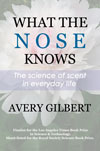
“The olfactory system was the thing that drove the expansion of the brain in the first place, and once you’ve got a big brain you can do all kinds of things with it.”A major theme in What the Nose Knows is that the sense of smell is more about brain than nose. Odor perception is cognitive and analytical, not merely emotional and reactive. And the computational aspect of odor perception is made possible by large and complex sensory processing areas in the brain.
--Timothy Rowe
Two studies this past year reinforce the point. The first involves developments at the dawn of the Age of Mammals; the second is about changes in the human lineage that, in the context of evolutionary time, occurred only yesterday.
The first study, led by paleontologist Timothy Rowe at the University of Texas, used high-resolution CT scans of fossil skulls to create digital endocasts, or 3D models, approximating the brain shape of two long-extinct creatures thought to be the precursors of today’s mammals.
The mammalian lineage diverged from ancestral tetrapod reptiles around 300 million years ago. By the Late Permian, about 260 million years ago, these pre-mammals consisted of a group called the Cynodontia.
Today’s mammals are characterized by high ratio of brain to body size, as measured by the encephalization quotient or EQ. The EQs of early cynodonts were nothing to write home about; they were low and ranged from ~0.16 to 0.23. Having relatively little brains, they were sensory dullards: they “possessed low-resolution olfaction, poor vision, insensitive hearing, [and] coarse tactile sensitivity.”
Then, in the Early Jussasic (around 199 million to 175 million years ago), came a tiny proto-mammal called Morganucodon with a chart-busting EQ of ~0.32, almost half again as large as it predecessors. Morganucodon’s most expanded brain areas were the olfactory bulb and the olfactory (or piriform) cortex, areas responsible for integrating and interpreting sensory information from the nose. Along with other modifications, the shape and proportion of Morganucodon’s brain now makes it look more like that of living mammals than its cynodont relatives.
Later, a creature called Hadrocodium arrived on the scene with a second pulse of encephalization. It had an EQ of ~0.5, which puts it squarely within the range of today’s mammals. Again, “expanded olfactory bulbs and olfactory cortex account for most of the increase” in brain size.
The so-called crown Mammalia—the first true mammals—evolved soon after, and were distinguished by further olfactory refinements: “the ethmoid turbinals ossify to form both the cribriform plate and a rigid scaffold in the nasal cavity for epithelium containing the odorant receptor neurons.” In other words, the modern mammalian brain began to take shape. Importantly, the ossified turbinal bones provided a ten-fold increase in available surface area in the nasal cavity—that much more space for olfactory sensory neurons.
“ . . . the brain in the ancestral mammal differed from even its closest extinct relatives specifically in its degree of high-resolution olfaction, as it exploited a world of information dominated to an unprecedented degree by odors and olfaction.”Timothy Rowe and his colleague believe that the core feature of mammalian evolution—the development of big brains—was led by the nose.
The second study, published in December in Nature Communications, is by paleoanthropologist Markus Bastir at the Spanish National Museum of Natural Sciences, and a group of European collaborators. They used CT scans to create digital 3D models of the skull base of over 100 specimens. These included chimps, modern humans, early human fossils, and fossil skulls from Homo neanderthalensis or Neanderthal man.
Bastir’s team measured the distances between anatomical landmarks in the skulls, and used principal components statistical analysis to characterize the results. They found that modern Homo sapiens are unique in having larger olfactory bulbs and a relatively wider orbitofrontal cortex. The latter is the cortical brain area devoted to analyzing odor information from the nose and olfactory bulbs.
Early proto-humans in the genus Homo split into two lineages. One led to the Neanderthals, the other led to us. Bastir’s results show that our lineage developed bigger olfactory bulbs and olfactory brain areas than our now extinct Neanderthal cousins.
So much for Freud’s silly, pseudo-evolutionary fantasy about olfactory “repression” and the declining importance of the human sense of smell. Precise measurement of actual skulls shows just the opposite. Brain areas supporting olfaction led the expansion of the early mammalian brain, and also increased during our recent evolution away from early hominids and Neanderthal man.
The studies discussed here are “Fossil evidence on origin of the mammalian brain,” by Timothy B. Rowe, Thomas E. Macrini, and Zhe-Xi Luo, published in Science 332:955-957, 2011, and “Evolution of the base of the brain in highly encephalized human species,” by Markus Bastir, Antonio Rosas, Philipp Gunz, Angel Peña-Melian, Giorgio Manzi, Katerina Harvati, Robert Kruszynski, Chris Stringer, and Jean-Jacques Hublin, published in Nature Communications, 2:588, 2011. For useful commentary on Rowe et al., see “Evolving large and complex brains,” by R. Glenn Northcutt, in Science 332:926-927, 2011.




4 comments:
Uh, how do EQs get calculated again? Who has brain mass/body mass or brain volume/body volume = 0.5 (50%)? Or were those EQs 0.1-0.5%?
Thanks.
EdC:
My bad. The way my post reads one could easily get the impression that EQ is the ratio of brain weight to body weight. It’s not—quite.
Bigger mammals generally have bigger brains. Converted to logarithmic scale, the brain vs. body weight data across many species form a straight line function. In other words, this function shows expected brain weight for a given body weight.
EQ is defined as the ratio of actual brain weight to expected brain, based on this straight line function.
Among mammals, primates have large EQs, and humans have the largest: from 6 to 8, depending on whose calculations you use.
Here’s a good review.
Avery,
You and I may be the only ones who care but the factors of 0.16 growing to 0.5 appear to be the B factors in equation 1 of the paper you recommended (the y intercepts in the log-log plots). The human EQ must be a bit smaller or larger dependending on whether the fit was done to data that include or exclude humans.
The application to smell seems double edged. The olfactory bulb can be a really small fraction of our really big brain and still be objectivly large. We can have impressive potential to process smells and still make much greater use of sight, sound and touch in managing our way through the world. This gives me hope that, with work, I can improve my sense of smell.
Will follow in a reader. I have been following Walter Freeman, UCLA Berkely, since the 80's, and other basic neuro work until 2006. I have always been blessed with a French sense of smell, but lost it 2006. Lately I found I could smell freshly dropped fewmets at the Zoo. On the next visit, I was too late, no smell, but I was joyous. Have always loved smell associated with horses. Then my neighbor was sick in the bathroom, on oxygen 24/7, and I let myself in when there was no response. He was being ill, colonically, to c oin a word, and I smelt it momentarily. I rushed home to see if I could smell my Bellogia. Only for a split second. Something about the smell of ordure still functions, so I feel I should light little stink bombs to turn my nose on and then rush to smell an old perfume. I am going to try xylitol nose spray, which I just found out about today, and see if that will bring back my nose. Wish me luck, and refer me to a link if you know of one and are so moved.
Post a Comment